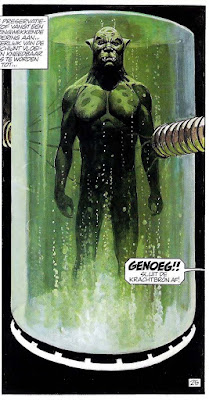Storm: The Hounds of Marduk (1985)
(Dutch: De Honden van Marduk) (part 3)
Art by Don Lawrence; script by Martin Lodewijk
The tattooed fisherman who rescue Storm, Nomad, and Ember come from a place called Pandarve's Ribs. Ember won't seem to wake up. The fisherman explains that she must have taken in some of the waste-water from the sewer, which has an intoxicating effect.
Meanwhile, the hound of Marduk they encountered previously has run far to the north. Marduk still watches through the creature's eyes. he and his servants don't know where the it was when it saw Storm, so they have no clue as to where to find him.
The fisherman take Ember to their shaman to cure her. The old man proclaims that since she is in "the sleep of Pandarve, only Pandarve's breath" can save her:
As no one can be "naked" on the Ribs, Storm and Nomad are sent off to get temporary tattoos while Ember is treated.
As days past, the hound makes its way back to its master. Marduk has an idea of what to do to allow the hound to tell him Storm's location. He transforms him into a humanoid form so he is capable of speech:
Back on the ribs, members of the Anti-Marduk group that was trying to capture Storm in the city sneak up and kidnap Ember. She awakens before they make their escape, and her cries summon Storm and Nomad. They threaten to kill Ember if Storm won't come with them.
Angrily, he agrees, and they leave the island in a small boat.
TO BE CONTINUED














